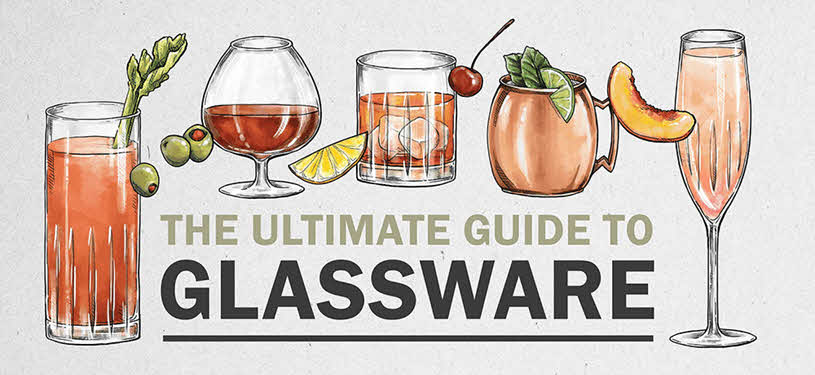
Drinkware is carefully designed to emphasize the character of the drinks it holds, be it the visual presentation, aromas, temperature or bouquet. Although it may seem perfectly acceptable to serve your Dry Martini in a tumbler, it can make a huge difference. Indeed, some enthusiastic mixologists go as far as claiming that the glass itself is almost as important as the spirits served in it. I think we can agree to disagree on that point.
In this Infographic, we explore some of the most commonly used drinkware, the story behind its history, the design and how to select the right glassware for the drinks you are mixing.
Stay Informed: Sign up here for the Distillery Trail free email newsletter and be the first to get all the latest news, trends, job listings and events in your inbox.
Old Fashioned or Rocks Glass is commonly used to serve up pure spirits neat or on the rocks.
The Story – The Old Fashioned was first known as the “Whiskey Cocktail” and dates back to 1800. It typically features a lump of sugar, water, bitters and of course the spirits.
Snifter Glass also known as brandy snifter, cognac glass or balloon. This rounded glass is traditionally used to serve well-aged brown spirits.
The Story – The ancient Egyptians are thought to have used brandy for ritual practices as well as drinking. The style of the goblet shaped glasses used then were similar to today’s snifters.
Martini Glass is a V-shaped glass that is often referred to simply as a “cocktail glass” and traditionally holds a classic Martini made with gin and vermouth, garnished with an olive or lemon twist.
The Story – The history of the Martini glass is unclear. Rumor has it that the wide rimmed glass was invented during the Prohibition era in case the Speakeasy was raided, the drinker could swiftly discard the beverage without being caught.
Moscow Mule Cup is a copper mug that’s ideal fo the classic Moscow Mule made with vodka, ginger beer and lime.
The Story – Although the name might suggest it orginates in Russia, the Moscow Mule was first introduced in Los Angeles in the 1940s. Around that time, vodka was an unpopular spirit amongst Americans, and a common joke was that “vodka means horrible in Russian.” Ever since the vodka-based cocktail was introduced, it has been served in the iconic copper cups in cocktail bars around the world.
Julep Cup is a short silver cup that is synonymous with the Mint Julep cocktail, a classic drink made from bourbon, mint sugar and crushed ice.
The Story – The word “Julep” comes from the Arabic julab and Persian gulab, meaning “rosewater”, and refers to a sweet drink. The julep cup as we know it today can be traced back to the early 1800s and was created by American silversmiths from Kentucky.
Highball Glass is used to serve spirit-based ‘highball’ drinks that contain a large portion of a non-alcoholic mixer, traditionally club soda.
The Story – The most common drink formerly made in the glass was Scotch and carbonated water, a drink made for railroad workers in the late 19th century. It is thought the name ‘highball’ came from the colored ball near stations which signaled to trains that they were clear to go full speed ahead.
Hurricane Glass is generally used to serve tropical cocktails, such as its namesake Hurricane. It is often lavishly garnished and served with a straw or stirrer.
The Story – The first Hurricane cocktail was served at Pat O’Briens bar in New Orleans in the 1940s. According to legend, the bright red drink was traditionally served in a glass made from a hurricane lamp, from which both the cocktail and the glass got their name.
Margarita Glass is typically curvy, elegant and is predominately used to serve the celebrated tequila-based cocktail from which it took its name.
The Story – As with many other popular cocktails, several people claim to have invented the Margarita. This history of the glass is also hazy. One common tale is that the original Margarita glass was inspired by the champagne coupe and made out of recycled Coke bottles.
Champagne Flute has a narrow unique flute shape that is perfectly suited for champagne or champagne cocktails.
The Story – Traditionally, champagne was enjoyed in coupes. It was not until the 1950s, when champagne enthusiasts claimed that the narrow flute could preserve the bubbles, that the flute came into prominence. The debate over whether flutes or coupes are better suited to the drink is ongoing, however many traditionalists actually prefer a wine glass which helps capture the complex aromas of Champagne.
Take a look at The Complete Guide to Glassware Infographic below to get all the details along with typical sizes, a list of suitable drinks, and more information about the design of each glass.
Enjoy!

Please help to support Distillery Trail. Sign up for our Newsletter, like us on Facebook and follow us on Twitter.
Resource: The Fairmont




